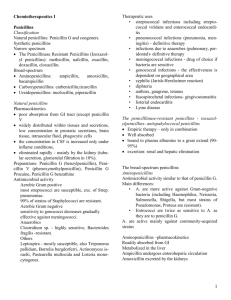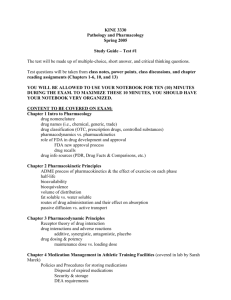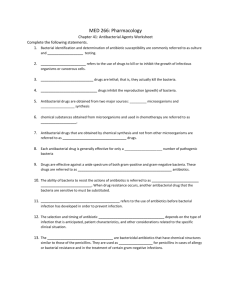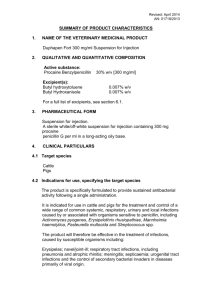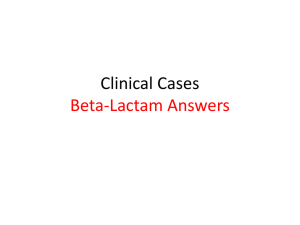The Penicillins - Available Courses
advertisement
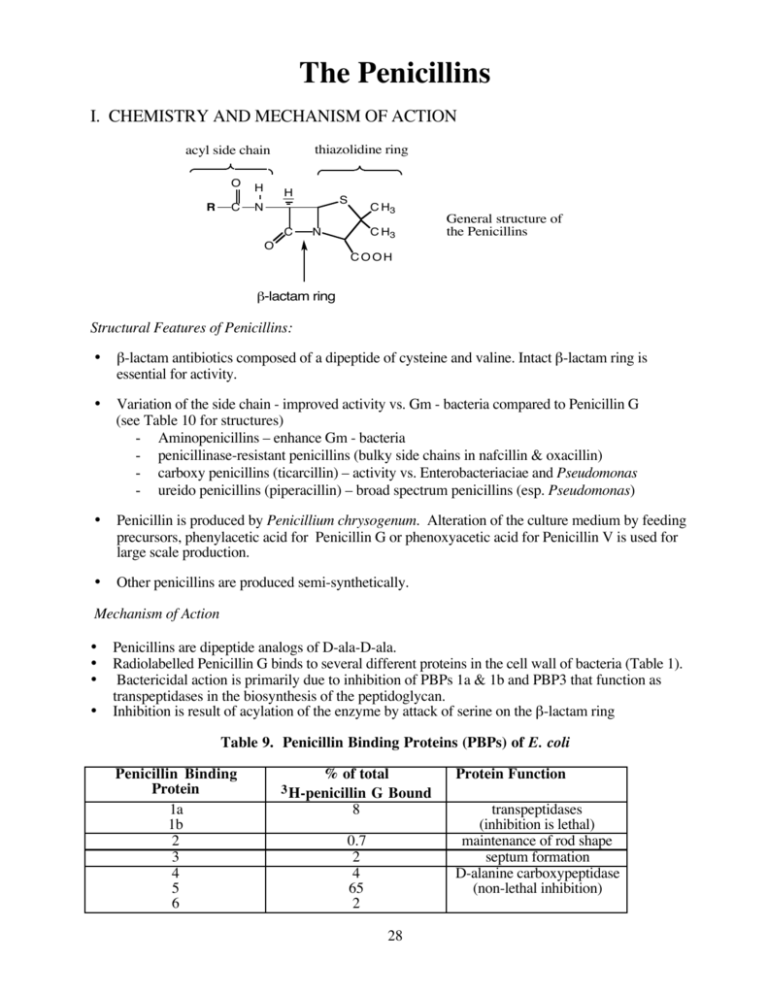
The Penicillins I. CHEMISTRY AND MECHANISM OF ACTION thiazolidine ring acyl side chain O R C H H S N C C H3 N C H3 General structure of the Penicillins O COOH b-lactam ring Structural Features of Penicillins: • b-lactam antibiotics composed of a dipeptide of cysteine and valine. Intact b-lactam ring is essential for activity. • Variation of the side chain - improved activity vs. Gm - bacteria compared to Penicillin G (see Table 10 for structures) - Aminopenicillins – enhance Gm - bacteria - penicillinase-resistant penicillins (bulky side chains in nafcillin & oxacillin) - carboxy penicillins (ticarcillin) – activity vs. Enterobacteriaciae and Pseudomonas - ureido penicillins (piperacillin) – broad spectrum penicillins (esp. Pseudomonas) • Penicillin is produced by Penicillium chrysogenum. Alteration of the culture medium by feeding precursors, phenylacetic acid for Penicillin G or phenoxyacetic acid for Penicillin V is used for large scale production. • Other penicillins are produced semi-synthetically. Mechanism of Action • • • • Penicillins are dipeptide analogs of D-ala-D-ala. Radiolabelled Penicillin G binds to several different proteins in the cell wall of bacteria (Table 1). Bactericidal action is primarily due to inhibition of PBPs 1a & 1b and PBP3 that function as transpeptidases in the biosynthesis of the peptidoglycan. Inhibition is result of acylation of the enzyme by attack of serine on the b-lactam ring Table 9. Penicillin Binding Proteins (PBPs) of E. coli Penicillin Binding Protein 1a 1b 2 3 4 5 6 % of total G Bound 8 Protein Function 3 H-penicillin 0.7 2 4 65 2 28 transpeptidases (inhibition is lethal) maintenance of rod shape septum formation D-alanine carboxypeptidase (non-lethal inhibition) Table 10. Structure of Representative Penicillins R O H C N H C S N C H3 C H3 O COOH Penicillin!!!!!!!!!!!!!!!!!!!!!!!!!!!!!!!!!!!!!Side Chain Penicillin G C H2– R Penicillin V O-CH2– R Ampicillin CH–R N H2 Amoxicillin HO CH–R N H2 O-C2H 5 Nafcillin R R Oxacillin N C H3 O CH–R Ticarcillin COOH S CH–R Piperacillin NH C=O N O O N C 2H 5 29 II. CLASSIFICATION OF THE PENICILLINS Table 11. Classification, Route of Administration, and Trade Names of Penicillins Type and Generic Name Natural Penicillins Penicillin G (benzylpenicillin) Penicillin G procaine Penicillin G benzathine Penicillin V (phenoxymethyl penicillin) Penicillinase-Resistant Penicillins Methicillin Oxacillin Nafcillin Cloxacillin Dicloxacillin Extended-Spectrum Penicillins (Aminopenicillins) Ampicillin Amoxicillin Bacampacillin Broad-Spectrum Penicillins (Anti-Pseudomonal Pencillins) Carboxypenicillins Carbenicillin indanyl Ticarcillin Ureidopenicillins Piperacillin ß-Lactamase Combinations Amoxillin-clavulanic acid Ampicillin-sulbactam Ticarcillin-clavulanic acid Piperacillin-Tazobactam Route of Administration IV, PO IM IM PO Trade Names Pentids, Pfizerpen Wycillin, Duracillin Bicillin L-A, Permapen Pen-Vee K, Veetids IV, IM IV, IM, PO IV, IM, PO PO PO Staphcillin Bactocill, Prostaphlin Unipen, Nafcil, Tegopen, Cloxapen Dynapen, Dycill IV, IM, PO PO PO Omnipen, Polycillin Amoxil, Trimox, Wymox Spectrobid 30 PO IV Geocillin Ticar IV Pipracil PO IV IV IV Augmentin Unasyn Timentin Zosyn III. MECHANISMS OF RESISTANCE A. INACTIVATION BY ENZYMES (_-LACTAMASES) 1. Gram positive bacteria secrete _-lactamases outside of cell wall 2. Gram negative bacteria - _-lactamases are present in periplasmic space 3. Over 30 different _-lactamases are known. TEM-1 is most common & has the broadest spectrum (includes cephalosporins). TEM-1 is common in Enterobacteriaciae, Ps. aeruginosa, H. influenzae, and N. gonorrheae. SHV-1 & K1 found in Klebsiella Table 12. Classification of _-Lactamases Organism Ps.aeruginosa Enterobacter sp. Citrobacter sp. Serratia sp. RichmondSykes Class Representative Enzymes I Preferred Substrates DNA Locus Cephalosporins Chromosomal Inducible Penicillins Penicillins & Cephalosporins Chromosomal Constitutive Plasmid Constitutive Penicillins & Cephalosporins Penicillins Chromosomal Constitutive Plasmid Inducible Plasmid & Constitutive Chromosomal Unknown Constitutive Proteus sp. Enterobacteriaciae H. influenzae Klebsiella sp. Klebsiella sp. II III Enterobacteriaciae Ps. aeruginosa Staph. aureus Bacteroides fragilis V resembles I Penicillins Cephalosporins B. melaninogenicus resembles V Penicillins IV TEM-1 TEM-2 SHV-1 K-1 OXA 1-7 PSE 1-4 PC-1 31 Plasmid Gene Expression Constitutive Another classification scheme for _-lactamases has been developed by K. Bush (K. Bush, G.A. Jacoby, A.A. Madeiros, Antimicrobial Agents and Chemother. 1211-1233, 1995) based on the substrate activity. This new scheme is being more widely used than the older Richmond-Sykes classification. Table 13. Bush, Jacoby, Madeiros Classification of _-Lactamases Group Characteristics 1 Cephalosporin-hydrolyzing _-lactamases not inhibited by clavulanic acid Typical Enzymes P99 ampC S&A PC1 569 TEM-1 & 2 Organism E. cloacae E. coli Ps. aeruginosa 2a Penicillin-hydrolyzing _-lactamases Staph. aureus inhibited by clavulanic acid B. cereus 2b Broad spectrum _-lactamases Enterobacteriaceae & inhibited by clavulanic acid H. influenzae SHV-1 Enterobacteriaceae ROB-1 H. influenzae 2b' Extended-broad spectrum b-lactamases TEM-3 Enterobacteriaceae inhibited by clavulanic acid SHV-2 Enterobacteriaceae K1 Klebsiella oxytoca 2c Carbenicillin-hydrolyzing b-lactamases PSE-1,3, &4 Ps. aeruginosa inhibited by clavulanic acid CARB-3 & 4 Ps. aeruginosa BRO-1 & 2 Moraxella catarrhalis AER-1 Aeromonas sp. 2d Cloxacillin-hydrolyzing b-lactamases OXA-1 Enterobacteriaceae inhibited by clavulanic acid PSE-2 Ps. aeruginosa 2e Cephalosporin-hydrolyzing b-lactamases L2 Stentroph. maltophilia inhibited by clavulanic acid SC10950 Proteus vulgaris 2f Carpapenemase inhibited by clavulanic acid IMP-1 (C) Ps. Aeruginosa Sme-1 (C) Sernatia mercesceus 3 Metallo- b-lactamases L1 Stentroph.. maltophilia CcrA B. fragilis 4 Penicillin-hydrolyzing b-lactamases 249 Ps. cepacia not inhibited by clavulanic acid G-237 B. fragilis LCR-1 Adapted from Mandell, Bennett, and Dolin (eds.), Mandell, Douglas & Bennett's Principles and Practice of Infectious Diseases, 4th ed., Churchill Livingstone, New York, 1994, p. 215. B. ALTERED PERMEABILITY TO PENICILLINS 1. Resistance due to alterations in porins in Gm – outer membrane. Mechanism for resistance to broad-spectrum penicillins. C. ALTERED PENCILLIN BINDING PROTEINS 1. Operative mechanism for resistance in staphylococci to penicillinase-resistant penicillins and increasing resistance to penicillin G observed in Strep. pneumoniae. MecA gene in Staphylococi produce penicillin-binding protein (PBP) 2a with reduced affinity for b-lactams. 32 IV. SPECTRUM & USES A. PENICILLIN G AND PEN VK SPECTRUM 1. Strep. pneumoniae, Strep. pyogenes, Group B Strep., viridans group Strep., however penicillin-resistant strains of Strep. pneumoniae are emerging (as high as 60% in endemic areas). If MIC < 0.1 µg/ml - Pen G or V is DOC. 2. Staphylococcus aureus (non-penicillinase producing strains) 3. Enterococcus faecalis, E. faecium (in combination with aminoglycosides) 4. Neisseria meningitidis 5. Treponema pallidum (syphilis) 6. Listeria monocytogenes 7. Corynebacterium diphtheriae 8. Anaerobes - Clostridum perfringens & C. tetani (not C. difficile), Bacteroides fragilis (non-penicillinase producing strains), Fusobacterium, Peptostreptococcus Table 14. Comparison of MIC Values between Penicillin G and Penicillin V (for non-penicillinase producing strains) Organism Staph. aureus Strep. pyogenes Strep. pneumoniae Enterococcus faecalis E. coli Salmonella typhi Neisseria gonorrheae N. meningitidis Haemophilus influenzae MIC for Pen G (µg/ml) 0.03 0.007 0.015 2.0 64.0 4.0 0.007 0.03 1.0 MIC for Pen V (µg/ml) 0.03 0.015 0.03 4.0 128.0 64.0 0.03 0.25 4.0 Acid Stability Pen G is very labile in acid (half-life = 5 min at pH 2, 37˚C) compared to Pen V (half-life = 5h at pH 1). Consequently, Pen V should be used when oral penicillin is indicated. 33 B. USES FOR PENICILLIN G AND PENICILLIN V 1. Streptocococcal Infections - Pen G is the most potent compound of all the penicillins and cephalosporins for susceptible Gram + bacteria. Pen V is normally used for oral administration (more acid stable). Resistance is looming as a major problem. a. Strep throat & scarlet fever - Strep. pyogenes is generally sensitive b. Streptococcal skin and soft tissue infections (Erysipelas & cellulitis) caused by Strep pyogenes , c. Pneumonia & Meningitis due to Strep. pneumoniae • • • Intermediate resistance (0.1-1.0 µg/mL) ~20-30% of all strains Resistant (≥2.0 µg/mL) ~15% of community strains Pen G is DOC for Strep. pneumoniae after sensitivity testing. High doses will cover most intermediate-resistant strains. d. Endocarditis due to Strep. viridans & Enterococcus sp. • Enterococcal endocarditis(Pen G in combination with Aminoglycosides) • Group B Strep., Viridans group Streptococci - usually sensitive to Pen G alone e. Anaerobic streptococcal infections & Peptostreptococcus 2. Gram positive rods - Clostridia (anaerobic infections) & Bacillus sp. a. Tetanus b. Gas gangrene c. Anthrax 3. Meningococcal Infections – Neisseria (Gram – cocci) • • Meningitis due to N. meningitidis - usually sensitive to high dose Pen G Meningococcemia – overwhelming sepsis 4. Syphilis • • • Primary syphilis –single dose of Benzathine Penicillin G as Treponema pallidum is exquisitely sensitive to low concentrations. Secondary syphilis – Procaine Pen G Neurosyphilis - high dose Pen G (continuous infusion) 5. Prophylaxis for scarlet fever - recent local epidemics of scarlet fever (Group A streptococci) have occurred in U.S. – Benzathine Pen G 34 C. SPECTRUM and USES OF PENICILLINASE-RESISTANT PENICILLINS 1. Staphylococcal Infections • • • • Spectrum similar to Pen G, but includes Staph. aureus & Staph. epidermidis. Community-acquired Methicillin-resistant forms of Staph aureus (MRSA) are infrequent but increasing. 50-80% of S. epidermidi in hospitals is methicillin-resistant, but Staph. epi . is not as invasive or virulent. Staphylococci cause skin infections (impetigo), abcesses in many organs, pneumonias, prosthetic joint, catheter, and artificial valve infections, endocarditis, meningitis (rare), & bone infections (osteomyelitis). Osteomyelitis may require months of therapy. 2. Streptococcal infections (use when Staph. is also a possibility) – almost as active as Pen V. D. SPECTRUM OF AMINO-PENICILLINS (Amoxicillin & Ampicillin) 1. Have similar Gram + spectrum to Penicillin V & K (slightly less active) 2. E. coli, Proteus mirabilis - especially for UTIs (however 25-50% make ß-lactamase) 3. Haemophilus influenzae - resistance is common (30-40%) & Neisseria sp., Listeria 4. Shigella & Salmonella - usually treat with ampicillin for GI infections (resistance is over 50% for Shigella in U.S.) Table 15. MIC Values (µg/ml) of Extended-Spectrum Penicillins vs. Gm – Bacteria Organism Escherichia coli Proteus mirabilis Klebsiella sp. Enterobacter spp. Citrobacter diversus Citrobacter freundii Serratia Salmonella Shigella Proteus vulgaris Providencia Morganella Pseudomonas aeruginosa Acinetobacter Pseudomonas, other Ampicillin Amoxicillin 3 3 200 >500 >100 50 >500 1.5 1.5 >500 >500 200 >500 Carbenicillin Ticarcillin 6 1.5 >400 50 12 12 100 3 3 12 12 25 50 Piperacillin 250 >500 25 100 32 >100 35 8 1 16 16 8 32 32 4 8 16 8 8 16 E. USES OF AMINO-PENICILLINS Note: Amoxicillin is the number one antibiotic sold in U.S. 1. Otitis Media - still drug of choice. • Strep. pneumoniae resistance is increasing. Vaccine should reduce incidence of invasive infections but may not be effective vs. all otitis media strains. • Haemophilus type b infections are rapidly decreasing due to vaccination, but vaccine is directed against capsular antigens. Haemophilus sp. that cause otitis media are not encapsulated, vaccine is not effective. 40-50% are penicillinase + • Moraxella catarrhalis strains are b-lactamase positive and are resistant. 2. Bronchitis/Pneumonia – may be used, but resistance is a problem. 3. Enterococcal endocarditis (ampicillin or PenG + aminoglycoside is DOC) 4. Meningitis – Ampicillin - alternative choice to 2nd gen. cephalosporins (+ chloramphenicol). • Infant meningitis – Ampicillin covers Strep. pneumoniae, N. meningitidis, H. influenzae • Neonatal meningitis - group B Strep., Listeria, & E. coli. (the most common causative organisms) • Some strains of Strep. pneumoniae, H. influenzae & E. coli are resistant. DOC for Listeria (in combo with gentamicin). Note: cephs are not active vs. Listeria 5. Urinary Tract Infections - Covers three most common organisms E. coli, Proteus mirabilis, & Staph. Saprophyticus but resistance is common in E. coli 6. Prophylaxis for bacterial endocarditis - 2 gm 1 h prior to dental procedures - DOC 7. Lyme Disease (Borrelia burgdorferi) and Erlichiosis (Erlichia chaffeinsis) - alternate to doxycycline (1 g amoxicillin + 0.5 g probenicid q 8 h) 8. Alternate for susceptible strains of N. gonorrheae (3.5 g oral ampicillin or amoxicillin + 1 g probenecid.) G. SPECTRUM OF BROAD-SPECTRUM PENICILLINS 1. Pseudomonas aeruginosa - Ticarcillin 2-4 x better than carbenicillin (rarely used). Piperacillin 4-8x more potent, but more expensive. 2. Enterobacteriaceae (see Table 15) - activity is generally OK for urinary tract infections (typical MIC values are 2-16 µg/ml). Piperacillin has activity vs. Klebsiella. Piperacillin generally more potent against other Gm - bacteria. 36 H. USES OF BROAD-SPECTRUM (ANTIPSEUDOMONAL) PENICILLINS 1. Pseudomonas aeruginosa infections (often with aminoglycosides) 2. Mixed infections - good gram negative activity, covers most B. fragilis 3. Complicated urinary tract infections & prostatitis - Carbenicillin indanyl OK orally. 4. Surgical prophylaxis - intra-abdominal, gynecologic surgery I. PENICILLINS IN COMBINATION WITH b-LACTAMASE INHIBITORS The b-lactamase inhibitors that are commercially available are clavulanic acid, sulbactam, and tazobactam. These compounds act as suicide inhibitors of the b-lactamases. Unlike the penicillins and cephalosporins which are released from the enzyme site after opening of the blactam ring, these compounds are very slowly released after attack of the enzyme resulting in irreversible inhibition of the enzyme, i.e. the enzyme remains acylated. This protects the penicillins from degradation and expands the utility of these drugs. H Ala-237 O C NH b-lactamase acylation O O O CH-CH2O H N H NH O Ser-70 COOH CH-CH2O H N H COOH Acyl-enzyme intermediate with TEM-1 b-lactamase H O O OH H N Ala-237 CH-CH2O H + COOH NH OH NH deacylation H O (slow) NH Ser-70 Ser-70 37 O CH-CH2O H O H N COOH 1. Amoxicillin + clavulanic acid (Augmentin® - Glaxo-SK) H O C CH-CH2O H N O COOH Clavulanic acid a. Clavulanic acid extends spectrum to b-lactamase-producing organisms. Inhibits PC-1 b-lactamase of Staph.aureus and of anaerobic Bacteroides sp. b. Extended spectrum towards gram negative bacteria. Activity towards Richmond-Sykes Class II, III, IV, and V b-lactamases. Some Gm – blactamases are not inhibited (Richmond-Sykes Type I). . c. Clavulanic acid has some weak antibacterial activity itself. Binds to PBP-2. Combination with amoxicillin is synergistic for Klebsiella sp. Indications for Augmentin® are as follows: • • Otitis media, sinusitis, and respiratory tract infections (acute exacerbations of bronchitis or chronic obstructive pulmonary disease, COPD) due to b-lactamase producing H. influenzae & Moraxella catarrhalis. High strength formulation (Augmentin ES – 90 mg/kg) recently approved for otitis media due to Strep. pneumoniae • Skin and Skin-structure infections caused by b-lactamase-producing strains of Staph. aureus, E. coli, and Klebsiella sp. • UTIs due to b-lactamase-producing strains of E. coli, Enterobacter sp., and Klebsiella sp 2. Ampicillin + Sulbactam (Unasyn® -Roerig) O O S C C H3 N C H3 O COOH Sulbactam a. Similar to Augmentin®, but Unasyn® available for IV use. b. Sulbactam similar to clavulanic acid. Slightly more active against cephalosporinases. Less active toward TEM-2 of Enterobacteriaciae. Indications for Unasyn® are: i. Skin & soft tissue infections due to b-lactamase-producing strains of Staph. aureus, E. coli, and Klebsiella sp., Proteus mirabilis, Bacteroides fragilis, Enterobacter sp., and Acinetobacter calcoceticus. 38 ii. Intra-abdominal infections due to b-lactamase-producing strains of E. coli, Klebsiella sp., Enterobacter sp., and Bacteroides fragilis. iii. Gynecologic infections caused by b-lactamase-producing strains of E. coli and Bacteroides fragilis. iv. Useful in combination with aminoglycosides for treatment of endocarditis caused by Enterococcus sp. and Group D Strep. 3. Ticarcillin + clavulanic acid (Timentin® - Glaxo-SK) a. Extends spectrum towards b-lactamase-producing Enterobacteriaciae & Pseudomonas. For Pseudomonas infections, often combined with aminoglycosides. Indications are as follows: i. Septicemia due to b-lactamase-producing strains of Klebsiella sp., E. coli, Staph. aureus, & Ps. aeruginosa ii. Lower respiratory tract infections due to b-lactamase-producing strains of Klebsiella pneumoniae, S. aureus, H. influenzae, & Moraxella catarrhalis iii. Bone & joint infections due to b-lactamase-producing Staph. aureus. iv. UTIs (complicated & uncomplicated) due to b-lactamase-producing strains of E. coli, Klebsiella, Ps aeruginosa, Citrobacter sp., Enterobacter sp., Serratia marcescens, & Staph. v. Gynecologic infections: endometritis due to b-lactamase-producing strains of Prevotella (formerly Bacteroides) melaninogenica, Enterobacter sp., E. coli, Klebsiella pneumoniae, S. aureus, and Staph. epidermidis. vi. Treatment of mixed infections and for presumptive therapy prior to identification of the causative organisms. 4. Piperacillin + tazobactam (Zosyn® - Aventis) a. Extended spectrum. Indications are as follows: i. Appendicitis or peritonitis caused by b-lactamase-producing E. coli or Bacteroides fragilis ii. Uncomplicated & complicated skin and skin structure infections caused by piperacillin-resistant b-lactamase-producing Staph. aureus iii. Post-partum endometritis or pelvic inflammatory disease caused by piperacillin-resistant b-lactamase-producing strains of E. coli iv. Community-acquired pneumonia (moderate severity only) caused by piperacillin-resistant b-lactamase-producing strains of H. influenzae 39 V. ABSORPTION, DISPOSITION, AND METABOLISM TABLE 16. PHARMACOKINETIC PROPERTIES OF THE PENICILLINS Penicillin (Dose) Pen G Pen V % Oral Absorp. Food Ø Absorp. % % Protein Metab. bound Total Conc. Free Conc. t1/2 (hrs) t1/2 (hrs) (µg/ml) (µg/ml) normal renal imp 2 4 0.9 0.8 0.5 1.0 10 4 6 10 15 1.2 0.4 0.6 0.45 0.16 0.5 0.5 0.5 0.5 0.5 4 1 1 1.5 1.5 2.9 6.2 10.7 0.5 1 0.5 1.5 8 1 7.5 1.1 15 1.2 1.3 15 4 30 60 Yes No 55 80 20 55 Methicillin Oxacillin (0.5 g po) Cloxacillin (0.5 g po) Dicloxacillin(0.5 g po) Nafcillin (1g) Nil 30 50 50 Erratic Yes Yes Yes Yes 35 93 94 97 87 10 45 20 10 Ampicillin (0.5g po) Amoxicillin (0.5g po) Bacampicillin (0.8g) 40 75 95 Yes No No 17 17 17 10 10 10 Carbenicillin indanyl Ticarcillin (3 g) Piperacillin (2g IV) 30 No 50 2 15 Nil Nil 50 30 15 190 300 Clavulanic acid (0.125 g po) Sulbactam (0.5g IV) Tazobactam Temocillin 90 Some Nil Nil 25 38 55-75 10 85 10 No 3.5 7.5 12.9 3.3 13 85 150 7.8 1 4 4 17 Adapted from Mandell, Douglas, & Bennett, Principles and Practice of Infectious Diseases, 3rd ed., Churchill Livingstone, New York, 1990. 1. All penicillins have short half-lives (0.5-2 h) and must be given 3-4 times per day. 2. Penetration into CSF - very low when meninges are not inflamed. Penicillins with highest CSF penetration are ampicillin (mean 35% of serum, range 2-100%), ticarcillin (mean = 9.5% and 40% in 2 different studies), and piperacillin - (mean = 23% and 32% in 2 studies). Penicillinase-resistant penicillins (methicillin & nafcillin) show very poor penetration. 40 V. ADVERSE EFFECTS TABLE 17. ADVERSE REACTIONS ASSOCIATED WITH PENICILLINS Type of Reaction Frequency (%) Allergic Anaphylaxis (IgE mediated) Early urticaria (<72 h) Hemolytic anemia due to cytotoxic antibodies Serum sickness (Ag-Ab complex disease) Delayed hypersensitivity Contact dermatitis Idiopathic reactions Maculopapular skin rash Fever Late onset urticaria Gastrointestinal Diarrhea Enterocolitis Hematologic Hemolytic anemia Neutropenia Platelet dysfunction Hepatic Elevated SGOT level Electrolyte Disturbances Sodium overload Hypokalemia Hyperkalemia (acute) Neurologic Seizures Bizarre sensations Renal Interstitial nephritis Hemorrhagic cystitis 0.004-0.4 Occurs most frequently with: Penicillin G Rare Penicillin G (high dose) Rare Penicillin G Amoxicillin Ampicillin 4-8 4-10 Ampicillin Amoxicillin 2-5 <1 Ampicillin Ampicillin Rare 1-4 Pencillin G Penicillin G, Oxacillin, Piperacillin Carbenicillin Oxacillin, Nafcillin Carbenicillin 3 1-4 Variable Variable Rare Carbenicillin, Pen G (Na) Ticarcillin, Piperacillin Piperacillin, Ticarcillin Pen G, K salt Rare Rare Penicillin G Procaine Penicillin G 1-2 Rare Methicillin Methicillin Adapted from Mandell, Douglas, & Bennett's Principles and Practice of Infectious Diseases, 4th ed., Mandell GL, Bennet JE, and Dolin R (eds.), Churchill Livingstone, New York, 1995, p. 239 A. Rashes and Anaphylactic shock 1. Severe and potentially life-threatening anaphylaxis - should have epinephrine on hand if unsure. Rate is 4-15 per 100,000 courses of penicillin. 2. Caused by formation of hapten-protein complex. Anaphylaxis and rashes usually occur after an initial exposure. Skin testing is important tool to identify penicillinallergic patients. 3. "Ampicillin rash" - idiopathic reaction resulting in a maculopapular, late-developing rash. This is not a true penicillin allergy. May go away with continued treatment. May not occur again with repeated dosing. Incidence is less with amoxicillin 41 B. Seizures 1. Seizures may be precipitated if penicillins are infused intravenously at high doses too quickly. Should administer slowly over at least 10-15 minutes. VI. DRUG INTERACTIONS TABLE 17. DRUG INTERACTIONS OF THE PENICILLINS Precipitating drug Object drug Effect Description Parenteral penicillins Aminoglycosides Ø Incompatibility. Penicillins and AGs form insoluble complex. Do not mix together in IVs. May occur in vivo. Parenteral penicillins Anticoagulants ↑ Large IV doses increase prothrombin Heparin time. Penicillins Oral contraceptives Ø Interruption of steroid enterohepatic recycling. Results in ineffectiveness and breakthrough bleeding. Penicillins, oral Atenolol Ø Decreased absorption of atenolol with ampicillin. Allopurinol Amoxicillin ↑ Rate of ampicillin rash appears to be much higher with co-adminstration of allopurinol Bacteriostatic antibiotics Penicillins Ø Decreased effect of penicillins. e.g Tetracycline, Penicillins require growing cell wall to Macrolides, Chloramp. have an effect. 42 VII. PRODUCTS and DOSAGES Penicillin G Potassium (250 mg = 400,000 units) Oral tablets - 200,000 units, 250,000 units, 400,000 units, 500,000 units, 800,000 units Powder for oral solution - 400,000 units per 5 ml when reconstituted (Pentids® 400, Apothecon) Powder for Injection - 1,000,000 units, 5,000,000 units, 10,000,000 units, 20,000,000 units Procaine Penicillin G (intramuscular) Injection vials - 300,000 units/ml and 500,000 units/ml in 10 or 12 ml vials (Crysticillin®, Apothecon) Unit dose injections - 600,000 units and 1,200,000 units in 1 and 2 ml Tubex (Wycillin®, Wyeth) Syringes - 2,400,000 units per 4 ml disposable syringe (Wycillin®, Wyeth-Ayerst) For Gonorrhea: 4.8 million units (2.4 million) in each buttock + 1 g oral probenicid For primary, secondary, and latent Syphilis: 600,000 units daily for 8 days For Neurosyphilis: 2-4 million units per day plus 500 mg probenicid q 6 h for 10-14 days. For Neonatal (cogenital syphilis) - 50,000 units/kg Benzathine Penicillin G (intramuscular) Injection: 300,000 units per ml in 10 ml vials (Bicillin L-A®, Wyeth-Ayerst) Unit dose: 600,000 units, 1,200,000 units in 1 and 2 ml Tubex, (Bicillin L-A®, Wyeth-Ayerst) Syringes: 1,200,000 units in 2 ml syringe (Permapen®, Roerig), 2,400,000 units in 4 ml syringe (Bicillin L-A®, Wyeth-Ayerst) For rheumatic fever prophylaxis: 1.2 million units as single dose in adults every 4 weeks For syphilis: 2.4 million units IM in single dose For syphilis of >1 yr duration: 2.4 million units IM every week for 3 weeks. Penicillin G Benzathine and Procaine Combined Injection: 300,000 units, 600,000 units, 1.2 million units, or 2.4 million units per dose containing 1:1 mixture of procaine and benzathine penicillin G. (Bicillin® C-R, Wyeth-Ayerst) Injection: 900,000 units benzathine penicillin + 300,000 units procaine penicillin G (Bicillin® C-R 900/300, Wyeth-Ayerst) For Groups A,C,G, H, L, M streptocococcal infections: 2.4 million units for adults For pneumococcal infections (except meningitis): 1.2 million units for adults, 600,000 for children. Note: resistance in Strep. pneumonia is rising. No longer indicated for empiric therapy. Penicillin V Potassium Tablets: 125, 250, and 500 mg (Pen-Vee K® - Wyeth-Ayerst; V-Cillin K® - Lilly; Veetids® Apothecon; Beepen VK® - Glaxo SK) Powder for Oral Solution: 125 mg per 5 ml and 250 mg per 5 ml when reconstituted Adults: 250-500 mg q 6 h. Children: 25-50 mg/kg/day in divided doses q 6 h Nafcillin sodium Capsules: 250 mg (Unipen® - Wyeth-Ayerst) Powder for Injection: 500 mg, 1g, 2 g in vials, piggypack vials, & ADD-Vantage vials. 10g in bulk vials. (Unipen® - Wyeth-Ayerst, Nafcil® - Apothecon, Nallpen® - Glaxo SK) IV doses, adults: 3-6 g per 24 h. IM dose, adults: 500 mg q 4-6 h. Oral dose, adults: 250-500mg q 6h Infants and children: 25mg/kg twice daily, IM or 50 mg/kg/day in 4 divided doses orally. Oxacillin sodium Capsules: 250 and 500 mg (Bactocill®-Glaxo SK, Prostaphlin®-Apothecon) Powder for Oral solution: 250 mg/5ml when reconstituted. Powder for Injection: 250 mg, 500 mg, 1 g, 2 g, 4 g in vials, piggyback vials, and ADD-Vantage vials. (Bactocill®-Glaxo SK, Prostaphlin®-Apothecon). 10g in bulk vials. 43 Oxacillin sodium Oral doses: 500 mg-1 g q 4-6 h for at least 5 days. IV doses, adults: ≥ 1g q 4-6 h for severe infections up to 12 g/day Cloxacillin sodium Capsules: 250 and 500 mg (Cloxapen®-Glaxo SK) Powder for Oral solution: 125 mg/5ml when reconstituted. Adults: 250 mg q 6 h for mild to moderate infections. ≥500 mg q 6h for severe infections. Children 50 mg/kg/day in divided doses q 6 h. Dicloxacillin sodium Capsules: 250 and 500 mg (Dycill®-Glaxo SK, Dynapen®-Apothecon) Powder for Oral solution: 62.5 mg/5ml when reconstituted. (Dynapen®-Apothecon) Adults: 250 mg q 6 h for mild to moderate infections. ≥250 mg q 6h for severe infections. Children: 25 mg/kg/day in divided doses q 6 h. Ampicillin Capsules: 250 mg and 500 mg either as trihydrate or anhydrous. (Omnipen®-Wyeth-Ayerst, , Totacillin® - Glaxo SK, Principen® - Apothecon) Powder for Injection: 125 mg, 250 mg, 500 mg, 1g, 2 g in vials, piggyback and ADD-Vantage vials. (Omnipen-N®-Wyeth-Ayerst, Polycillin-N® - Apothecon, Totacillin-N® - Glaxo SK) as sodium salt (contains 3 mEq Na/ g). Adults: 1-12 g daily in divided doses every 4-6 hours Children: 50-200 mg/kg/day in divided doses q 6 h Prevention of bacterial endocarditis: 2 g IM or IV 30 minutes before dental procedure. Ampicillin sodium plus Sulbactam sodium Powder for Injection: 1.5 g (1 g ampicillin + 0.5 g sulbactam) or 3 g (2 g ampicillin + 1 g sulbactam) in vials, bottles, and Add-Vantage vials (Unasyn® - Pfizer). May be reconsituted in sterile water for injection, 0.9% NaCl, or 5% dextrose however it is less stable in 5% dextrose than in normal saline. Adults: 1.5-3 g q 6 hours. Do not exceed more than 4 g/day of sulbactam. Not indicated for children ≤12 years old. Amoxicillin Capsules: 250 mg and 500 mg as trihydrate (Amoxil® - Glaxo SK, Wymox® - Wyeth-Ayerst, Polymox® & Trimox® - Apothecon) Chewable tablets: 125 mg and 250 mg (Amoxil® - Glaxo SK) Powder for Oral Suspension: 125 mg per 5 ml and 250 mg per 5 ml when reconstituted. (Amoxil® - Glaxo SK, Wymox® - Wyeth-Ayerst, Polymox® & Trimox® - Apothecon) Amoxicillin Dosing: For URIs, otitis, UTIs, and skin & soft tissue infections: Adults: 250-500 mg q 8 hours Children: 20-40 mg/kgday in divided doses q 8 h. Gonococcal infections: 3 g single dose plus 1 g probenicid followed by doxycyline Prevention of bacterial endocarditis: 2 g 1 hour before procedure. For Genetourinary or GI procedures: 3 g 1 hour before procedure, then 1.5 g 6 hours after initial dose. For Chlamydia trachomatis in pregnancy: 500 mg q 8 h for 7 days. 44 Amoxicillin and Potassium Clavulanate (Augmentin® - Glaxo SK) Tablets: 250 mg amoxicillin + 125 mg clavulanate; 500 mg amox. + 125 mg clavulanate; 875 mg amoxicillin + 125 mg clavulanate Chewable Tablets: 125 mg amox/31.25 mg clav. (lemon-lime); 200mg amox/28.5 mg clav. (cherrybanana); 250 mg amox./62.5 mg clav. (lemon-lime); 400 mg amox./57 mg clav. (cherry-banana). Powder for oral suspension: 125 mg amox + 31.25 mg clav. per 5 ml when reconstituted (banana flavor); 200 mg amox. + 28.5 mg clav. per 5 ml (orange-rasberry flavor); 250 mg amox. + 62.5 mg clav. per 5 ml. (orange flavor); 400 mg amox. + 57 mg clav. per 5 ml (orange-rasberry flavor). Augmentin ES (Aproved 2001 by Glaxo SK to provide 90mg amox/6.4 mg clav per kg per d) - Powder for oral suspension: 600 mg amox. + 42.9 mg clav. per 5 ml Note: chewable tablet cannot be substituted with regular tab Augmentin dosing (based on amoxicillin content): Adults: One 250 mg tablet every 8 hours or one 500 mg tablet q 12h. Severe infections and respiratory tract infections: One 875 mg tablet q 12h or one 500 mg tablet q 8h To minimize GI effects, should take at the start of meals. Children ≤40 kg: usually 20 mg/kg/day. Otitis media, sinusitis, lower respiratory infections and severe infections in children: 80-100 mg/kg/d Carbenicillin indanyl sodium Film-coated tablets: 382 mg carbenicillin (Geocillin® - Pfizer) Urinary tract infections: 1 or 2 tabs QID Prostatitis: 2 tabs QID Ticarcillin disodium (Ticar® - Glaxo SK) Powder for injection: 1g, 3g, 6g, 20 g, and 30 g in vials. 3g in piggyback and ADD-Vantage vials. (Ticar® - SK-Beecham) For systemic infections: 200-300 mg/kg/day by IV infusion in divided doses every 3, 4, or 6 h For UTIs: 100-200 mg/kg/day every 4 to 6 hours. For uncomplicated infections in adults 1gm IM or IV every 6 hours. Ticarcillin and Clavulanate potassium (Timentin® - Glaxo SK) Powder for injection: 3g ticarcillin + 0.1g clavulanate in vials, piggback bottles and ADD-Vantage vials. Also available in 31g bulk vials. Contains 4.75 mEq of sodium/g. Reconstitute in Sodium chloride injection, 5% dextrose injection, or Lactated Ringer's. Solution: 3g ticarcillin + 0.1g clavulanate in 100 ml premixed, frozen vials. Contains 18.7 mEq sodium per 100ml Adult dose: 3.1 g every 4 hours (reduce dose and give less frequently if renally impaired) Piperacillin sodium (Pipracil® - Aventis) Powder for injection: 2 g, 3 g, 4 g in vials, infusion bottles, and ADD-Vantage vials. 40g in bulk vials Severe infections: 12-18 g/day IV in divided doses every 4-6 hours UTIs: 8-16 g/day IV in divided doses every 6 to 8 hours Surgical prophylaxis: 2 g IV just priory to surgery, 2 g in surgery, 2 g q 6h post-op up to 24 hours Piperacillin sodium plus Tazobactam sodium (Zosyn® - Aventis) Powder for injection: 2 g piperacillin/0.25 g tazobactam, 3 g piperacillin/0.375 g tazobactam, and 4 g piperacillin/0.5 g tazobactam in vials. Adult dose: 12 g piperacillin/1.5 g tazobactam in divided doses of 3.375 g every six hours (adjust dose in patients with renal dysfunction) 45
